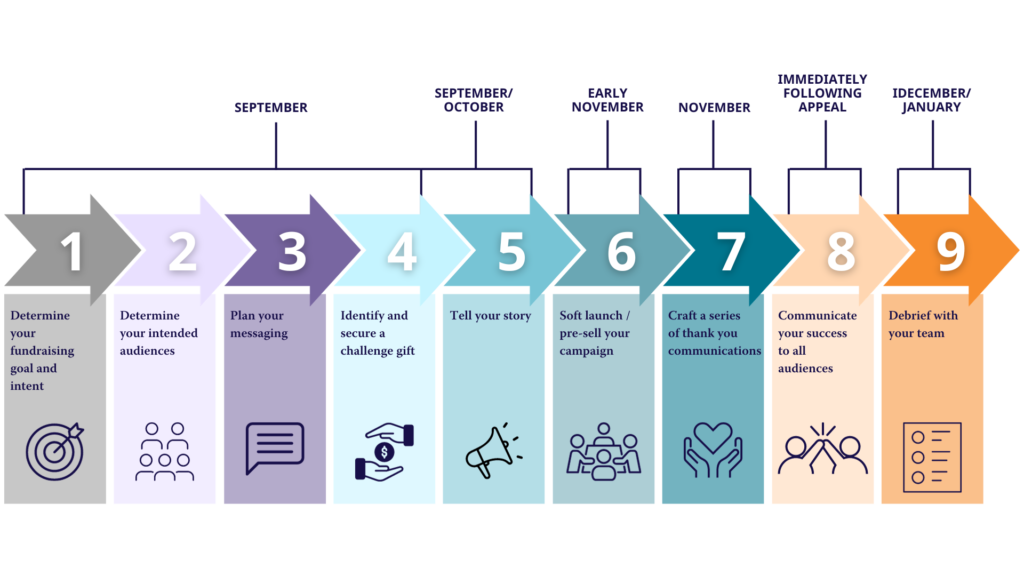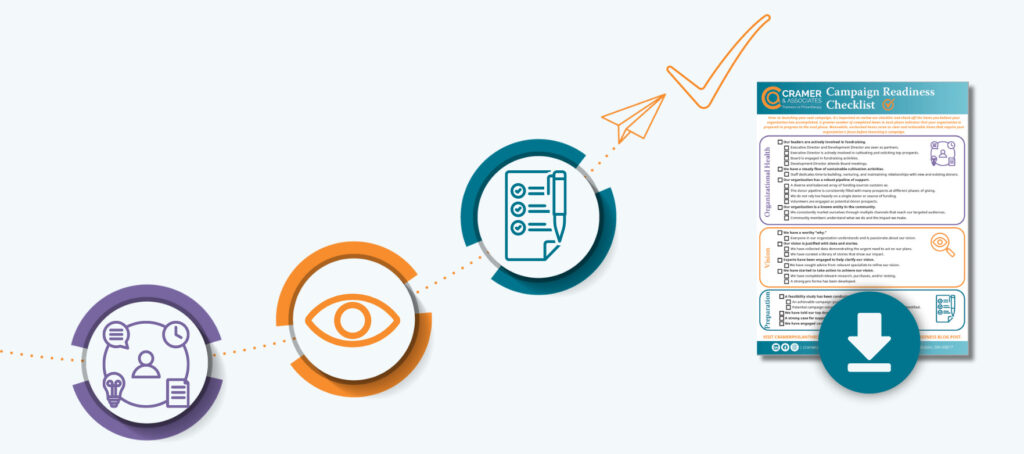It’s that time of year again. Kids are back in school, the temperatures are starting to drop, and your Board is asking the questions: “Are we going to make our year-end goal?” “Are we doing #GivingTuesday this year?”
Whether you already have a plan in place for your end-of-year appeal and #GivingTuesday, or you need some inspiration, Cramer is here to help.
While you can certainly incorporate direct mail into your plan, our nine action steps will primarily focus on digital content. Why? Because according to a recent study1, email has the highest ROI of any kind of marketing channel, and nonprofits have one of the highest open rates at 25.2%. Additionally, 32% of donors who give online said that social media is the channel that inspires them to give.
Download our End-of-Year Appeal and #GivingTuesday Checklist and dive deeper into each of the nine steps below.

Let’s kick things off by diving into step one:
1: Determine your fundraising goal and intent (September)
Fundraising Goal: As the year draws to a close, it’s time to prepare for your #GivingTuesday and year-end appeals. The first step is to set a realistic goal, as well as an internal “audacious but quiet” goal. If you raised $25,000 last year, consider aiming for the same amount or slightly higher, like $27,500. Your audacious but quiet goal could be $35,000, or 25% more than last year. Keep this audacious goal within your team and plan a small celebration if you come close to meeting it.
The most successful appeals usually inform donors of the intended fundraising goal. However, you can also share the goal in creative ways that help donors understand the tangible impact of their donation. Here are a couple examples:
Our goal is to feed 100 families this holiday season.
Your donation this #GivingTuesday will ensure that homeless teens have a safe and warm place to sleep at night.
Intent: What will donations go toward? Historically we have seen that end-of-year and #GivingTuesday appeals that are aimed toward something specific are more successful. Donors want to give to something tangible that they know will help the organization. Do you need a new industrial washer? Funds to spruce up a serenity garden or front landscape? New Chrome Books for your staff or students? If you need donations to be unrestricted, say so in a series of tangible ways:
$100 will ensure a child has a bed to sleep in during the holidays.
$250 will provide a local family with a holiday dinner and food for their family throughout the festive season.
2: Determine your intended audiences (September)
While most nonprofits will send out their end-of-year appeal to their entire database, #GivingTuesday is a perfect time to target a segment of donors, like your LYBUNT (Last Year But Unfortunately Not This year) and/or SYBUNT (Some Year But Unfortunately Not This year) lists. Or maybe you work for a school and want to re-engage graduates from the 2000s.
And don’t overlook your volunteers! Nonprofits often overlook them as a segment of potential donors. #GivingTuesday is a perfect time to engage your volunteers and ask them for what may be a first-time monetary gift.
3: Plan your messaging (September)
Once you have identified your goal, intent, and target audiences, it’s essential to plan your messaging. Since your message will primarily be in digital form, it’s crucial to keep it concise. Avoid repeating your organization’s long history. Use action words in your headlines and subject lines and descriptive language to tell compelling stories. If you’ve segmented your audience, establish a specific message for each segment. Lastly, make sure that you clearly communicate how each gift will make a difference using respectful, inclusive language that aligns with your brand and the communities you serve.
4: Identify and secure a challenge gift (September)
One of the most successful ways to raise end-of-year dollars or reach your quiet audacious goal for #GivingTuesday is to secure a challenge gift. Telling your audience that their gift will be doubled provides a huge incentive for donors.
Look through your database to see who typically gives you a sizeable gift at the end of the year and reach out to them. Ask them if they would consider making their gift a challenge gift this year. They can remain anonymous, but chances are if you meet or exceed your fundraising goal, you will also receive a second or larger gift from that challenge donor before the end of the year and secure their lifelong loyalty.
5: Tell your story! (September – October)
- Use visual content – It’s important to communicate your organization’s impact in a visually engaging way. We suggest using real photos instead of stock photography whenever possible. This adds authenticity and reliability to your storytelling. If you have short video content (under two minutes), use it sparingly in one e-appeal and two social media posts. Once you have created your appeal stories with complementary images or video, build out a content calendar to get those stories in front of donors.
- Create a content calendar – Your content calendar should use various channels to ensure donors see your #GivingTuesday or end-of-year appeal multiple times. If your donors are primarily on one or two social media channels, then concentrate on those channels only! This is not the time to test out your appeal on TikTok or BeReal—stick to your tried-and-true channels. To ensure success, use the following cadence: one direct mail appeal, two to three e-appeals spread across two months, and a series of 8-12 social media posts spread across three months. Also, be sure to check what you currently have scheduled in your content calendar. If your annual gala is in November, you will need to carefully time your end-of-year or #GivingTuesday content so it does not conflict with event-related content or hamper your event’s fundraising goals.
- Test your technology – According to recent research from Double the Donation, if a donor lands on your website and cannot find your “donate” button within three seconds, you have lost that donation. But making your donate button stand out on your website can result in a 190% increase in donations! Before you launch an e-appeal or social media post, send at least two tests to colleagues and friends and have them click on every live link to make sure they work properly. Nothing, and we mean nothing, can dissuade a donor from giving to your organization like bad or broken technology!
6: Soft launch/pre-sell your campaign (early November)
One effective way to kick start your #GivingTuesday or end-of-year appeal is by asking your closest supporters, such as Board members, staff, or long-time volunteers, to make the first donations. By doing so, you can celebrate an early “win” and generate momentum. When these donors receive a preview of your appeal, ask them to encourage others to join in. This will give you a great story to share with potential donors and show that you have already reached a certain percentage of your fundraising goal.
7: Craft a series of thank you communications (November)
Nothing frustrates a donor more than not getting a timely thank you! Just like testing your e-appeals, you need to test your automated thank you for online donations and make sure it goes out immediately after a donation is made. If you have not incorporated this AI component in all your online donation platforms, now is the time to do so. Then within 72 hours of their gift, your Development Director should send each donor a personalized and sincere thank you email.
8: Communicate your success to all audiences (day after #GivingTuesday/January)
Thank you communications are the final component of your appeal cadence. At the conclusion of your appeal (the Wednesday after #GivingTuesday, or the first week of January), a sincere and heartfelt thank you should be sent out both as an e-mail to all your donors and on all your social media channels. This thank you can be crafted in advance and should include how much was raised—even if you do not hit your goal. Sharing that you still need $500 or $5,000 can sometimes motivate a donor to give, or even give again.
9: Debrief with your team (December/January)
After your appeal, it is important to assess what went well and what needs improvement. We suggest gathering all your team members who made the appeal possible for breakfast or lunch and expressing your gratitude for their hard work. Then, take 30-45 minutes to ask for their input on what went right, where they faced obstacles, and what your organization can do better next year. Listen attentively to their suggestions and incorporate them into the plan for the following year. This debrief not only helps strengthen future appeals, but fosters team spirit and encourages a sense of ownership among team members.






